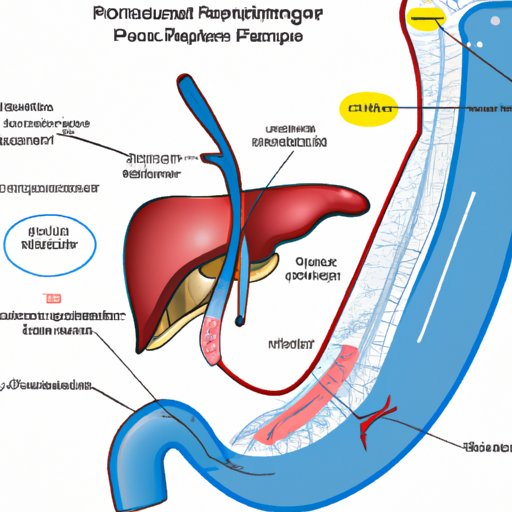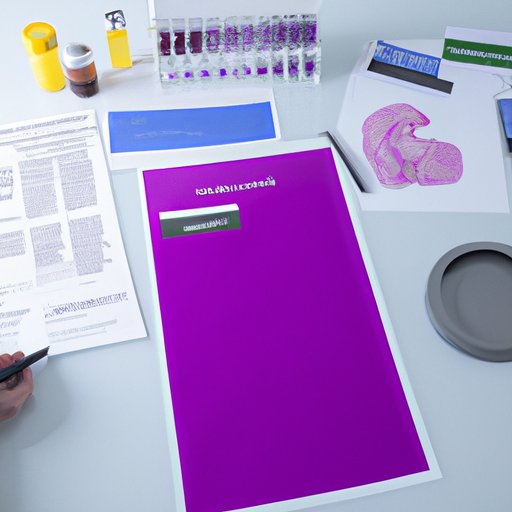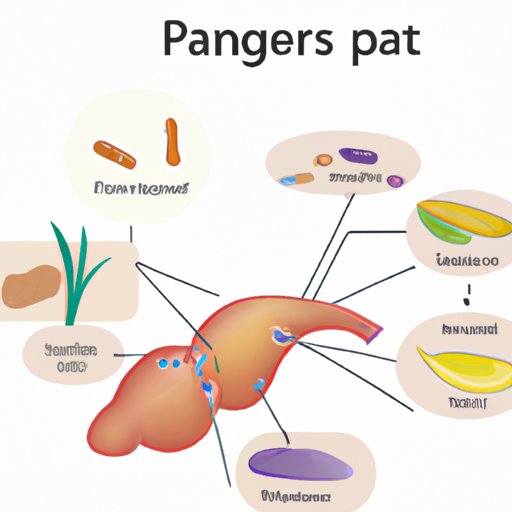Introduction
The pancreas is a small organ located in the abdomen that plays an important role in digestion as well as in producing hormones and enzymes that help regulate the body’s metabolism. This article will explore how the pancreas works, including its anatomy and physiology, how it produces hormones, enzymes, and bile, and how diet and nutrition affect its functioning.

Exploring the Anatomy and Physiology of the Pancreas
The pancreas is located deep in the abdomen, behind the stomach and in front of the spine. It is about six inches long and has two main parts: the head and the tail. The head is curved and lies next to the duodenum, which is the first part of the small intestine. The tail extends towards the left side of the body and connects to the spleen.
The pancreas is composed of three different types of cells: exocrine cells, endocrine cells, and duct cells. Exocrine cells are responsible for secreting digestive enzymes and bile, while endocrine cells produce hormones like insulin, glucagon, and somatostatin, which regulate glucose and fat metabolism. The duct cells line the tubes that drain the pancreatic juice into the small intestine.
The primary functions of the pancreas are to aid in digestion and to produce hormones that regulate metabolism. It produces and secretes pancreatic juices that contain enzymes that break down food in the small intestine, allowing for the absorption of nutrients. It also produces hormones, such as insulin and glucagon, which help control blood sugar levels.
Examining How the Pancreas Produces Hormones, Enzymes, and Bile
Hormones are chemical messengers that travel through the bloodstream and tell the body what to do. The pancreas produces two main hormones: insulin and glucagon. Insulin helps the body use glucose for energy and lowers blood sugar levels, while glucagon raises blood sugar levels. Other hormones produced by the pancreas include somatostatin, gastrin, and cholecystokinin.
Enzymes are proteins that help with digestion. The pancreas produces several different enzymes, including amylase, lipase, and trypsin. Amylase breaks down carbohydrates, lipase breaks down fats, and trypsin breaks down proteins. These enzymes are released into the small intestine, where they help break down food so that it can be absorbed.
Bile is a fluid produced by the liver that helps break down fat in the small intestine. It is stored in the gallbladder and released into the small intestine when needed. The pancreas also produces a type of bile called pancreatic juice, which contains bicarbonate to help neutralize the acid in the stomach.
Investigating Disorders and Diseases Related to the Pancreas
There are several disorders and diseases related to the pancreas, including type 1 diabetes, chronic pancreatitis, and acute pancreatitis. Type 1 diabetes is an autoimmune disorder in which the pancreas stops producing insulin. Chronic pancreatitis is a long-term inflammation of the pancreas that can lead to complications such as diabetes, malnutrition, and abdominal pain. Acute pancreatitis is a sudden inflammation of the pancreas that can cause severe abdominal pain and other symptoms.

Understanding How Diet and Nutrition Affect the Pancreas
Eating a healthy diet is essential for maintaining a healthy pancreas. Eating foods high in fiber and low in fat can help keep the pancreas functioning properly. Fruits, vegetables, whole grains, and lean proteins should be included in the diet, as these provide essential vitamins and minerals. Eating foods high in saturated fat can increase the risk of developing pancreatitis or diabetes.

Analyzing the Impact of Pancreatic Cancer on the Body
Pancreatic cancer is a serious condition that affects the pancreas. Symptoms may include weight loss, abdominal pain, jaundice, dark urine, and changes in appetite. Diagnosis is typically done through imaging tests such as CT scans or MRI. Treatment usually involves surgery, chemotherapy, and radiation therapy.
Investigating Treatments for Pancreatic Conditions
Treatment for pancreatic conditions depends on the type and severity of the condition. Medication may be prescribed to manage symptoms or to reduce inflammation. Surgery may be necessary to remove a tumor or to repair damage to the pancreas. Alternative therapies such as acupuncture, massage, and yoga may also be recommended to reduce stress and improve overall health.
Conclusion
In conclusion, the pancreas plays an important role in digestion and in regulating the body’s metabolism. It produces hormones, enzymes, and bile that help break down food in the small intestine. Certain disorders and diseases, such as diabetes and pancreatitis, can affect the pancreas, and diet and nutrition play an important role in maintaining its health. There are various treatments available for pancreatic conditions, depending on the type and severity.
(Note: Is this article not meeting your expectations? Do you have knowledge or insights to share? Unlock new opportunities and expand your reach by joining our authors team. Click Registration to join us and share your expertise with our readers.)
